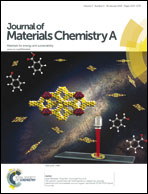Improving the dielectric constant and energy density of poly(vinylidene fluoride) composites induced by surface-modified SrTiO3 nanofibers by polyvinylpyrrolidone
Abstract
Compared to the spherical ceramic fillers, the one-dimensional ceramic fillers are more effective in enhancing the dielectric constant of the composites at low concentration because the depolarization factor is strongly dependent on the aspect ratio of the fillers. Moreover, their smaller specific surface can help to reduce the surface energy and thus prevent the nanofillers from agglomerating in the polymer matrix. The ceramic–polymer composites consisting of SrTiO3 nanofibers (ST NF) with a large aspect ratio prepared via electrospinning and modified by polyvinylpyrrolidone (PVP) as fillers and poly(vinylidene fluoride) (PVDF) as matrix have been fabricated by a solution casting method. The composites exhibit enhanced dielectric constant and reduced loss tangents at a low volume fraction of surface-modified ST NF. The composite containing 2.5 vol% of PVP modified ST NF exhibits an energy density as high as 6.8 J cm−3 at 3800 kV cm−1, which is more than double of the pure PVDF of 2.8 J cm−3 at 4000 kV cm−1. Moreover, the efficiency of the composites with 2.5 vol% PVP modified ST NF is higher than 85% at electric fields below 1000 kV cm−1 and still higher than 60% at an electric field of 3800 kV cm−1. Such significant enhancement is closely related to combined effects of the surface modification, large aspect ratio and paraelectric behavior of the ST NF.


 Please wait while we load your content...
Please wait while we load your content...